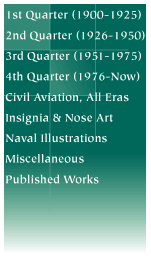
![]()

McDonnell Douglas F-15 Eagle
Part 1: Early F-15As
By Chris Banyai-Riepl
Developed during the same time as the Grumman F-14 Tomcat (featured last month), the F-15 Eagle quickly became the USAF's premiere air superiority fighter, with outstanding capabilities in a wide range of missions. From interceptor to ground attack, the F-15 has done its job admirably and will continue to do so well into the 21st century.
With such a long lifespan, a look at how the camouflage and markings have evolved for the F-15 is in order. We'll start off by looking at the early Eagles during the 1970s.
F-15A Eagle
73-106
Luke AFB
By the time the F-15 was entering service, the concept of using gray camouflages for fighters was resurfacing. Originally used to great effect by the Germans during the Second World War, camouflage in general and gray camouflage in particular fell out of vogue during the late 1940's and 1950's. By the time the Vietnam conflict rolled around, the Air Force was painting its planes up in a scheme to help blend them in with the ground. Unfortunately this made them very visible at altitude, something the Germans knew about during WW2. After experimenting with different colors (including an Air Superiority Blue), the two-tone gray scheme shown here was chosen.
F-15A Eagle
73-103
Luke AFB
Of course, adding bright red and white stripes to a plane defeats the whole purpose of camouflage. But in this case, the red and white stripes on the nose and wing (now shown) were used for training purposes. Other standard markings on Eagles for this period was the TAC badge on the tail. At this time, all tail codes were in white, conforming to a T. O. that was written for planes camouflaged in the much darker toned South East Asia camouflage scheme.
F-15A Eagle
75-042
Nellis AFB
Aside from the tail codes, the only real difference between F-15s was in the colored bands on the tail. This F-15 displays black and yellow checks, while the two Luke Eagles had a green band with white stars. These bands differed between the squadrons and was the only real source of color on the F-15. A special style of star and bar was used on these early Eagles, too. The standard star and bar incorporated a blue border around the whole emblem, while on the F-15s this was removed to reduce the visibility, leaving only the white/red/white bars and a blue circle with a white star.
F-15A Eagle
75-064
Bitburg, Germany
Speaking of Germany, many F-15s have flown over that country and were based on its soil during the Cold War. This particular F-15 flew from Bitburg and displays a very subdued scheme. No tail bands are present, and the white tail codes have been replaced by the more familiar black. The star and bar have remained the same, however. At roughly the same time as the change from white to black codes, the sparrow missiles slung under the fuselage were also camouflaged, with the bodies matching the color of the undersurfaces and the fins being a darker gray.

F-15C Eagle
'Gulf Spirit'
Technically not in the 'early' years of the F-15, this illustration is included as it is the one that appears on the back of the Revell-Monogram Snap-Tite kit of the Eagle.



